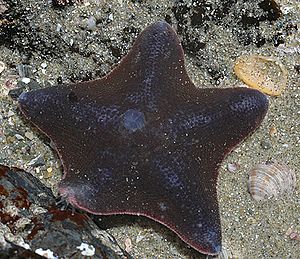New Zealand common cushion star facts for kids
Quick facts for kids Patiriella regularis |
|
|---|---|
 |
|
| Conservation status | |
|
Not evaluated (IUCN 3.1)
|
|
| Scientific classification | |
| Kingdom: | |
| Phylum: | |
| Class: | |
| Order: | |
| Family: |
Asterinidae
|
| Genus: |
Patiriella
|
| Species: |
P. regularis
|
| Binomial name | |
| Patiriella regularis (Verrill, 1867)
|
|
The New Zealand common cushion star, also known as Patiriella regularis, is a type of sea star. It is found only in New Zealand. This sea star can grow up to 60 mm wide, which is about the size of a small cookie.
It is one of the most common sea stars you can find on the rocky shores of New Zealand. You'll see lots of them in shallow waters around both the North and South Islands. These cushion stars come in many different colours. They usually have 4 to 6 arms.
Meet the New Zealand Cushion Star
This amazing sea star is super common in New Zealand. You can often spot them in tide pools and shallow ocean areas. They love to live on rocky shores.
What They Eat
Cushion stars are not picky eaters! They munch on things like algae, barnacles, and other small invertebrates. To catch their food, a cushion star does something cool. It puffs up its body like a cushion. Then, it slowly deflates on top of its prey. This helps it trap the food!
Where Else They Live
These sea stars were also brought to the waters of southeast Tasmania. They have settled in very well there. Some people worry they might become an invasive species. This means they could spread too much and harm the local plants and animals.
Life Cycle and Reproduction
New Zealand common cushion stars breed from January to March. After the eggs are fertilised, it takes about 9 to 10 weeks for the tiny larvae to grow. These larvae then change into young sea stars.
Cool Facts About Cushion Stars
Scientists have found something interesting about these sea stars. Cushion stars from the North Island of New Zealand are a bit different from those in the South Island. It seems that natural barriers, like land or ocean currents, might stop them from mixing together. This helps them stay unique in different areas.

